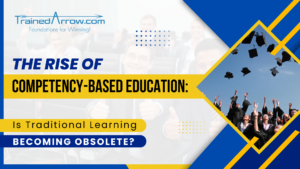
The Rise of Competency-Based Education: Is Traditional Learning Becoming Obsolete?
In an era where the ability to adapt is key, the traditional educational model is increasingly being questioned. With industries evolving and job markets demanding
![]()
Organizations commit to transformation and some also claim they have an “employee-first” policy. Yet, the real development to transform the workforce is a far cry.
Why?
Most organizations map their headcount to a number of future skills for re-training and certifications and conveniently view it as employee development. The emphasis usually is on tools for transformation rather than on employees, while the firm should focus on employees first (as claimed) and then tools for the medium-term. They need to rethink their employee development plan to be inclusive of the following tenets.

Resilience
Retraining has roots in the industrial mindset to give the ability of ‘doing things’ – either new things or old things in a new way, and to improving output per employee. This helps in the short term as employees focus on mastering the new skills to ‘keep their jobs’. But today, by the time a new skill is mastered, another skill is already in the asking. Lack of ‘resilience’ as strategic intent can be myopic for the development of employees. The key attribute employees need is to be resilient in the face of setbacks and disruptions – cope with change, adapt and become a force to generate profound outcomes.
Organizations that have imparted learning agility to build resilience have demonstrated high earning per employee!
Common foundation
Education isn’t mapped to shifting job markets, and employees come with varying educational backgrounds and age(s). Training or certifications in a particular skill may only theoretically be equal to enabling job-readiness, but not change-ready.
New skills or tools alone will not prepare employees to move out of comfort zone or reinvent to become change-enablers. They need a shift from … ‘following’ to ‘leading’ … and then the ripple continues.
Consider imparting broad-based foundational awareness of contemporary business and technologies irrespective of roles, age, and backgrounds. Neither training nor rigid certification, but knowledge and awareness, that which propel employees to get a holistic view of the business, the way they should see, stay update, communicate and act on shifting business and operating models, emerging technologies and dynamic capabilities – to be able to evolve with changing times and roles during Reorgs.
Capability delivery
Technology is changing the way work gets done, and often faster than training can keep up. What matters is plugging capability shortfalls and learning to deliver anticipated results. Different results need different capabilities. It is important to see capabilities through the end in sight – to understand and enable solutions for customer value. Impart how to leverage new/digital tools with functional adjacencies in the context of evolving work and customer value. It pays as employees unlock opportunities to be progressive in their own careers and the businesses they support.
Seeking culture
Learning gives new ideas which can prosper only when the culture is immunized for the fear of differing and distancing, and questioning the status quo.
A seeking ecosystem, that is empowering with the best and highest value enhances the connection of work with a sense of purpose – helping employees to relate to what they do why they do – to create proposed change with care and professionalism. This will be key to engagement after training. Culture and systems must promote learning and seeking, not to conform and consume instead. It also rewards the curiosity and jubilance associated with such innate endeavors, notwithstanding results.
Evolving minds
As they say, “… a TEACHER sends you on the road to success, whereas a GURU sends you on the road to freedom.” What employees need is the freedom to turn each moment of their work into an opportunity for excitement and also a step in their journey for growth. Know who they are, and start exploring to embrace change – change from within to feel more fulfilled in both their professional and personal lives. Self-awareness in the learning curriculum will help with much-needed dimensions: one, being true to oneself (self-directed); two, what you say you are to others – (others-directed). A third dimension of being able to consciously learn, unlearn and enrich life, and evolve with a higher purpose for life.
Intent
In essence, employers should not only prepare their employees for ‘another job,’ but also start building them for a career well-crafted with resilience and a life well-lived with a higher purpose. This is so true to Corporate Social Responsibility, as well.
In essence, employers should not only prepare their employees for ‘another job’ but also start building them for a career well-crafted with resilience and a life well-lived with a higher purpose.
Much appreciate your thoughts …
www.trainedarrow.com
ChangeAhead TM … for employee change enablement!

In an era where the ability to adapt is key, the traditional educational model is increasingly being questioned. With industries evolving and job markets demanding
![]()

In today’s fast-evolving world, disruption has become the new norm. Leadership is no longer just about managing resources or overseeing day-to-day operations—it’s about shaping a
![]()

As the modern workplace continues to evolve, adaptability and growth are no longer optional—they are necessities. At Trained Arrow, we understand the complexities of navigating
![]()
We are passionate about people development and transformation. Our courses are designed for: College Graduates, Corporate Employees, and Entrepreneurs. Interested?
trainedarrow@samprad.net
+1-609-658-3053